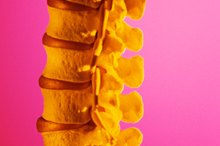Exercise Therapy for Cauda Equina Syndrome
Exercise can be effective in the treatment and management of a number of chronic health conditions. According to the American Academy of Orthopedic Surgeons, participation in physical activity can also be useful for those who suffer from acute conditions -- including cauda equina syndrome 123. Understanding which exercises to include and how to incorporate them into a daily routine is crucial for those living with this rare disorder.
If you are experiencing serious medical symptoms, seek emergency treatment immediately.
Cauda Equina Syndrome Basics
The American Academy of Orthopedic Surgeons describes cauda equina syndrome as a condition that affects a group of nerves at the base of the spinal cord 12. The condition often develops as a result of a sudden, violent impact, such as from a car crash, a fall from a great height or a gunshot wound. However, certain chronic conditions such as a tumor, infection or ruptured disk can also cause the condition. Cauda equina syndrome -- or CES -- is a medical emergency and requires immediate treatment from a health care professional 2.
Benefits of Exercise
Exercises for Congestive Heart Failure Patients
Learn More
Exercise is highly effective in restoring losses in strength and balance following a CES diagnosis. Regular physical activity can also be helpful when it comes to improving circulation and blood flow to the lower extremities -- a common problem for those living with this condition. Consistent exercise can boost mood and decrease symptoms of depression, making it a must for those diagnosed with CES.
Incorporating Aerobic Exercise
Aerobic exercises, such as walking, biking and swimming are often recommended for CES patients. These types of exercises not only help to strengthen muscles and improve balance but are also effective in improving the functioning of the circulatory system. For best results, patients should walk, bike, swim, jog or hike for at least 30 minutes a day, five days per week. Individuals who are very weak or out of shape should start with five to 15 minutes per day and increase their time slowly to ensure optimal results.
- Aerobic exercises, such as walking, biking and swimming are often recommended for CES patients.
- For best results, patients should walk, bike, swim, jog or hike for at least 30 minutes a day, five days per week.
Incorporating Strengthening Exercise
Facet Joint Syndrome Pain & Helpful Exercises
Learn More
Resistance-training exercises, including hamstring curls, leg extensions and calf raises can also help to increase strength and endurance. Cauda equina syndrome patients should perform two to three sets of 10 to 15 repetitions of these exercises once or twice per week 2. Space these resistance-training sessions out during the week to allow the muscles adequate amounts of recovery time.
Maintaining Safety
Ensuring safety during exercise is crucial for those who are living with CES. Often, patients will be encouraged to work with an occupational or physical therapist for assistance in starting an exercise program. Patients may be required to attend several weeks of rehab therapy before they have been deemed healthy enough to engage in independent physical activity.
Related Articles
References
- American Academy of Orthopedic Surgeons: Cauda Equina Syndrome
- Cauda Equina: Other Problems
- American Heart Association: American Heart Association Recommendations for Physical Activity in Adults
- Gardner A, Gardner E, Morley T. Cauda equina syndrome: a review of the current clinical and medico-legal position. Eur Spine J. 2011;20(5):690-7. doi:10.1007/s00586-010-1668-3
- American Association of Neurological Surgeons. Cauda Equina Syndrome.
- Lavy C, James A, Wilson-MacDonald J. Cauda equina syndrome. BMJ. 31 Mar 2009. 338:b936. doi:10.1136/bmj.b936
Writer Bio
Kathryn Vera holds a master's degree in exercise physiology, as well as licensure as a Registered Dietitian. Currently, she works as a Clinical Exercise Physiologist in Cardiac Rehabilitation, where she provides care to patients living with chronic heart disease.









